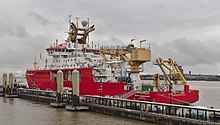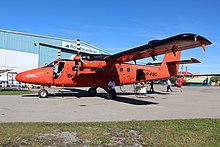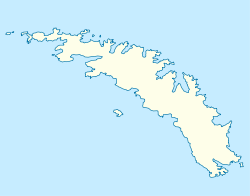British Antarctic Survey
 | |
| Abbreviation | BAS |
|---|---|
| Formation | 1962 |
| Legal status | Government organisation |
| Purpose | Scientific research and surveys in theAntarctic,Arctic& related regions |
| Headquarters | Cambridge,Cambridgeshire,England |
Region served | United Kingdom |
Director | ProfessorDame Jane Francis |
Parent organisation | Natural Environment Research Council |
Budget | £48,053,000 (2011–12)[1] |
Staff | 400+ staff |
| Website | www |
TheBritish Antarctic Survey(BAS) is the United Kingdom's national polar research institute. It has a dual purpose, to conduct polar science, enabling better understanding ofglobal issues,and to provide an active presence in theAntarcticon behalf of the UK. It is part of theNatural Environment Research Council(NERC). With over 400 staff, BAS takes an active role in Antarctic affairs, operating fiveresearch stations,one ship and five aircraft in both polar regions,[2]as well as addressing key global and regional issues. This involves joint research projects with over 40 UK universities and more than 120 national and international collaborations.
Having taken shape from activities duringWorld War II,it was known as theFalkland Islands Dependencies Surveyuntil 1962.
History
[edit]Operation Tabarinwas a small British expedition in 1943 to establish permanently occupied bases in the Antarctic. It was a joint undertaking by theAdmiraltyand theColonial Office.At the end of the war it was renamed theFalkland Islands DependenciesSurvey(FIDS) and full control passed to the Colonial Office. At this time there were four stations, three occupied and one unoccupied. By the time FIDS was renamed the British Antarctic Survey in 1962, 19 stations and three refuges had been established.[3]
In 2012 the parent body,NERC,proposed merging the BAS with another NERC institute,National Oceanography Centre in Southampton.[4]This proved controversial, and after theHouse of Commons Science and Technology Committeeopposed the move[5]the plan was dropped.[6]Since April 2018 NERC has been part of UK Research and Innovation.[7]
Directors
[edit]
In 1956, the FID Scientific Bureau and FIDS Rear Base were combined into a single FIDS London Office, with a Director for the first time responsible for the whole London operation.[8]
| Portrait | Director | Term start | Term end |
|---|---|---|---|
| Raymond Priestley | 1956 | 1958 | |

|
Vivian Fuchs | 1958 | 1973 |
| Richard Laws | 1973 | 1987 | |

|
David Drewry | 1987 | 1994 |

|
Barry Heywood | 1994 | 1997[9] |

|
Chris Rapley | 1998 | 2007 |

|
Nick Owens | 2007 | 2012 |
| Alan Rodger | 2012 | 2013 | |

|
Jane Francis | 2013 | Incumbent |
Research stations
[edit]Antarctica
[edit]The BAS operates five permanent research stations in theBritish Antarctic Territory:
- Rothera Research StationonAdelaide Island
- Halley Research Stationon theBrunt Ice Shelf
- Signy Research StationonSigny Island
- Fossil Blufflogistics facility onAlexander Island
- Sky Blulogistics facility inEllsworth Land
Of these Research Stations, only Rothera is manned throughout the year.[10]Before 2017 Halley was also open year-round.[11]
-
Rothera Research Station
-
Halley VI[12]
-
Sky Blu
-
Signy
-
Fossil Bluff
South Georgia
[edit]The BAS also operates two permanent bases onSouth Georgia:[12]
- King Edward Point Research StationatKing Edward Point
- Bird Island Research StationonBird Island
Both South Georgia bases are manned throughout the year.
Other sites
[edit]
The headquarters of the BAS are in the university city ofCambridge,onMadingley Road.This facility provides offices, laboratories and workshops to support the scientific and logistic activities in the Antarctic.[13]
The BAS also operates theNy-Ålesund Research Stationon behalf of theNERC.This is anArcticresearch base located atNy-Ålesundon the Norwegian island ofSpitsbergen.[14]
Equipment
[edit]Ships
[edit]
As of 2021, the Survey operates one ship, theRRS Sir David Attenborough,for support of Arctic and Antarctic research operations, and other logistical work.[15]It replacedRRS James Clark RossandRRS Ernest Shackleton,which were sold in 2021 and returned to its owners in 2019, respectively. Originally, theAdmiraltyprovided the FIDS[nb 1]with ship support. In 1947 the Survey purchased their first vessel, which was named MV John Biscoe, and in 1953 the same ship was grantedRoyal Research Shipstatus. Since then the Survey has owned and chartered several vessels.[16][17]
Vessels depart from the United Kingdom in September or October of each year and return to the United Kingdom in the following May or June. Vessels undergo refit and drydock during the Antarctic winter, but are also used elsewhere during this period.[citation needed]
The civilian ships operated by the BAS are complemented by the capabilities of theRoyal Navy's ice patrol vessel that operates in the same waters. Until 2008 this wasHMSEndurance,a Class 1A1icebreaker.Endurance'stwoLynx helicoptersenabled BAS staff to get to remote field sites that BAS aircraft could not access.[18]However, acatastrophic flooding accidentleftEndurancebadly damaged, with a replacement only being procured in 2011. This ship,HMSProtector,first deployed to the Antarctic in November 2011.[19]
Aircraft
[edit]

BAS operates five aircraft in support of its research programme inAntarctica.The aircraft used are all made byde Havilland Canadaand comprise fourTwin Ottersand oneDash 7(as of August 2019).[20]The planes are maintained by Rocky Mountain Aircraft inSpringbank,Alberta,Canada.During the Antarctic summer the aircraft are based at theRothera base,which has a 900-metre gravel runway. During the Antarctic winter, conditions preclude flying and the aircraft return to Canada.[21]
The larger Dash 7 undertakes regular shuttle flights between eitherPort Stanley Airporton theFalkland Islands,orPunta Arenasin Chile, and Rothera. It also operates to and from the ice runway at the Sky Blu base. The smaller Twin Otters are equipped with skis for landing on snow and ice in remote areas, and operate out of the bases at Rothera, Fossil Bluff, Halley and Sky Blu.[21]
Findings
[edit]
In 1985, the British Antarctic Survey discovered thehole in the ozone layerover Antarctica. The finding was made by a team of three BAS scientists:Joe Farman,Brian GardinerandJonathan Shanklin.Their work was confirmed by satellite data, and was met with worldwide concern.[22]
In January 2008, a team of British Antarctic Survey scientists, led by Hugh Corr andDavid Vaughan,reported that 2,200 years ago, avolcanoerupted under Antarctica's ice sheet (based onairborne surveywith radar images). The biggest eruption in the last 10,000 years, the volcanic ash was found deposited on the ice surface under theHudson Mountains,close toPine Island Glacier.[23]
In 2020, a team reported thatemperor penguincolonies inAntarcticawere nearly 20% more numerous than previously thought, with new discoveries made using satellite mapping technology.[24][25]
Polar image collection
[edit]The BAS runs an onlinepolar image collectionwhich includes imagery of scientific research at the poles, logistics operations, and the continent and its wildlife. The image collection is run by British cameraman and photographer Pete Bucktrout, who has visited the continent eleven times during his 24 years working for BAS. His work has been seen in newspapers and on television around the world.
See also
[edit]- Instituto Antártico Argentino(Argentine Antarctic Institute)
- Instituto Antártico Chileno(Chilean Antarctic Institute)
- Operation Tabarin
- British Antarctic Territory
- Faraday Research Station
- List of organizations based in Antarctica
- National Antarctic Program
Notes
[edit]- ^Falkland Islands Dependencies Survey, direct predecessor to the BAS
References
[edit]- ^"Business Plan 2011"(PDF).British Antarctic Survey.Archived fromthe original(PDF)on 4 July 2012.Retrieved3 September2012.
- ^"BAS Vision and Mission".British Antarctic Survey.Retrieved30 March2021.
- ^"British Research Stations and Refuges – History".British Antarctic Survey.Retrieved30 March2021.
- ^McKie, Robin (29 September 2012)."Antarctic research at risk as government cuts back on science".The Observer.Retrieved4 November2012.
- ^"Think again on British Antarctic Survey merger say Science and Technology Committee".UK Parliament Website. 31 October 2012.Retrieved4 November2012.
- ^Carrington, Damian; McKie, Robin (4 November 2012)."Research Boss Wingham in trouble over British Antarctic Survey claim".The Observer.Retrieved4 November2012.
- ^"Who we are".UK Research and Innovation.Retrieved30 March2021.
- ^Fuchs, Sir Vivian E. (1982).Of Ice and Men. The Story of the British Antarctic Survey 1943-1973.Anthony Nelson.
- ^"British Antarctic Survey - Media post - Death of Barry Heywood".UK National Archives Web Archive.National Archives.Retrieved8 January2024.
- ^Blake, David (September 2005)."Extreme Engineering".Ingenia(24). Archived fromthe originalon 2 October 2011.Retrieved28 March2010.
- ^Patrick Sawer (5 December 2015)."The ice station that needs saving from the abyss".The Telegraph.Archivedfrom the original on 12 January 2022.Retrieved11 November2018.
- ^ab"Research Stations in Antarctica".British Antarctic Survey.Retrieved31 December2007.
- ^"BAS Cambridge".British Antarctic Survey.Archived fromthe originalon 5 October 2007.Retrieved31 December2007.
- ^"Ny-Ålesund Arctic Research Station".British Antarctic Survey.Archived fromthe originalon 23 December 2007.Retrieved2 January2008.
- ^"Research ships".
- ^"History of BAS ships".
- ^"MV/RRS John Biscoe (1)".
- ^"HMS Endurance – Ice Patrol Vessel".British Antarctic Survey.Archived fromthe originalon 7 June 2011.Retrieved31 December2007.
- ^"Protector sails on her debut voyage to the ice".Royal Navy.Archived fromthe originalon 2 December 2011.Retrieved1 December2011.
- ^"Global Airline Guide 2019 (Part One)".Airliner World(October 2019): 13.
- ^ab"Aircraft in Antarctica".British Antarctic Survey.Archived fromthe originalon 29 January 2008.Retrieved31 December2007.
- ^"The Ozone Layer".British Antarctic Survey.18 May 2015.Retrieved30 November2015.
- ^Black, Richard (20 January 2008)."Ancient Antarctic eruption noted".BBC News.Retrieved28 March2010.
- ^"Throng of new penguin colonies in Antarctica spotted from space".The Guardian.5 August 2020.Retrieved5 August2020.
- ^"Scientists discover new penguin colonies from space".British Antarctic Survey.5 August 2020.Retrieved5 August2020.
Further reading
[edit]- "History of BAS Research Stations".British Antarctic Survey, history.Retrieved25 March2021.
- Bingham, E. W. (1947). "The Falkland Islands Dependencies Survey, 1946-47".Polar Record.5(33–34): 27–39.Bibcode:1947PoRec...5...27B.doi:10.1017/S0032247400037165.S2CID140158872.
- Bryan, Rorke (2011).Ordeal by Ice: Ships of the Antarctic.Seaforth Publishing.
- Dudeney, J. R.; Walton, D. W. (2012). "From Scotia to Operation Tabarin - Developing British Policy for Antarctica".Polar Record.48(4): 342–360.Bibcode:2012PoRec..48..342D.doi:10.1017/S0032247411000520.S2CID145613031.
- Fogg, G. E. (1992).A History of Antarctic Science.Cambridge University Press.
- Fuchs, V. E. (1951). "The Falkland Islands Dependencies Survey, 1947-50".Polar Record.6(41): 7–27.Bibcode:1951PoRec...6....7F.doi:10.1017/S0032247400040894.S2CID251050677.
- Fuchs, Sir Vivian E. (1973).Evolution of a Venture in Antarctic Science - Operation Tabarin and the British Antarctic Surveyin Frozen Futureedited by Lewis, R. S. and Smith, P.M.New York: Quadrangle Books. pp. 234–239.
- Haddelsey, S. (2014).Operation Tabarin: Britain's Secret Wartime Expedition to Antarctica, 1944–46.Stroud: History Press.ISBN9780752493565.
- Headland, Robert K. (2020).A Chronology of Antarctic Exploration.Cambridge University Press.
- James, D. P. (1949).That Frozen Land.Falcon Press.
- Pearce, Gerry (2018).Operation Tabarin 1943-45 and its Postal History.Gerry Pearce.ISBN978-1-78926-580-4.
- Robertson, S. C. (1993).Operation Tabarin.BAS.Information booklet produced for 50th anniversary.
- Walton, Kevin; Atkinson, Rick (1995).Of Dogs and Men: Fifty Years in the Antarctic. Illustrated Story of the Dogs of the British Antarctic Survey.Images (Booksellers & Distributors) Ltd.ISBN1-897817-55-X.
- Wordie, J. M. (1946). "The Falkland Islands Dependencies Survey, 1943-6".Polar Record.4(32): 372–384.Bibcode:1946PoRec...4..372W.doi:10.1017/S0032247400042479.S2CID129588807.
External links
[edit]- Official website

- Polar Picture Library
- Discovering Antarctica — teaching and learning resources on Antarctica
- BAS science programmes
- BAS research stations
- BAS Online Palaeontology Collection
- BAS history
- British Antarctic Oral History Project- Includes interviews with many who served with Tabarin, FIDS and BAS.
- BAS Club- A membership club for those employed by, or closely associated with, BAS and its predecessors (Operation Tabarin, FIDS)
- British Antarctic Survey
- Antarctica research agencies
- British Antarctic Territory
- Buildings and structures in Cambridge
- Natural Environment Research Council
- Scientific organizations established in 1943
- Organisations based in Cambridge
- Environment of South Georgia and the South Sandwich Islands
- United Kingdom and the Antarctic
- Buildings and structures in South Georgia and the South Sandwich Islands
- Partner institutions of the University of Cambridge



![Halley VI[12]](https://upload.wikimedia.org/wikipedia/commons/thumb/b/b1/Halley_VI_Antarctic_Research_Station_-_view_from_North_East.jpg/100px-Halley_VI_Antarctic_Research_Station_-_view_from_North_East.jpg)


